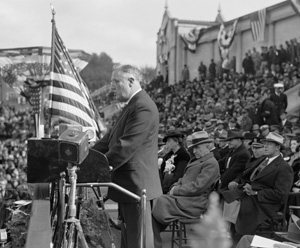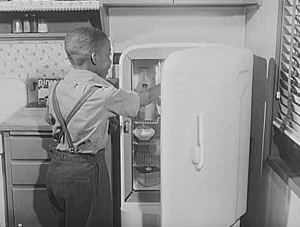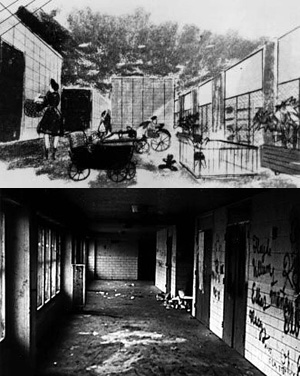It Wasn't Always So

President Franklin Roosevelt at the 1935 dedication of the Techwood Homes in Atlanta, Ga.
Photo courtesy Kenan Research Center at the Atlanta History Museum
"We had regular stores, we had A&P, we had two movie theaters, everything we needed was right here," says Sarah Ruffin, a longtime resident of public housing.
"It was great." Crystal Palmer agrees: "We didn't have electricity, running water, it was cold, and then we moved to public housing where my whole family could live in one unit together. We had heat, water, you could take a bath."
Sarah Ruffin and Crystal Palmer are recalling what it was like to live in the Henry Horner Homes in the early 1960s. When the first Horner apartments opened in 1954, like public housing around the country, it was a big step up in living standards for poor people who previously lived in squalid slums. For instance, the 1942 Frances Cabrini Homes occupying 16 acres in Chicago was "built on the site of a notorious Italian-American slum known as Little Hell," writes Witold Rybeczynski, professor of real estate at the Wharton School.
America's modern embrace of subsidized public housing for the poor began during the Great Depression as part of Roosevelt's New Deal. Much of public housing was designed by well-known architects. Appliances were modern and they had running water. The notion was that these were temporary homes for the "deserving poor," folks down on their financial luck.
"During the '30s and '40s, planners, progressive housing reformers, and government officials alike saw government-sponsored public housing as a viable solution to the squalor and disease of America's growing urban slums and as a much needed source of employment," writes Paul R. Lusignan, a historian with the National Register of Historic Places.
Problem is, in the post-World War II economy, public housing became increasingly designed as cities within cities. The move partly reflected the impulse of reformers determined to rehabilitate crumbling inner city neighborhoods.
"The solution - bulldoze existing houses and replace them with tall apartment slabs spaced far apart in open parkland (created by closing off existing streets to make immense 'super-blocks') - reflected the prevalent social and architectural thinking of the time," writes Rybczynski.

In the kitchen of the Carr home. Ida B. Wells Housing Project, Chicago, Ill.
Photo by Jack Delano/Library of Congress
The separation also reflected deeply entrenched racism. For instance, when the Pruitt-Igoe apartments in St. Louis opened the plan called for whites to live in Igoe and blacks in Pruitt. But no whites would move so close to blacks, and pretty soon the entire complex had only black residents.
"In the South the ideology of racial inferiority became a way of life, deeply entrenched and resistant to change," writes Robert Margo, economic historian at Boston University. "In the North the same ideology was active, but it was geared more towards residential segregation than disenfranchisement and economic subjugation."
Take Chicago. It was no coincidence that blacks and public housing were confined to the south and west side. It was a deliberate policy of Mayor Richard J. Daley and the Chicago Housing Authority. That's what Alexander Polikoff learned after suing the CHA for racial discrimination in the projects in 1966. He recalls that at the time just showing a pattern of geographic segregation wasn't enough to prove discrimination. He had to show the reason behind the segregation, "and that reason had to be racial animus, racial motivation, a desire to keep blacks out of white 'hoods," he says.
They found a written trail at the CHA and elsewhere in government.
"We found some memos and we had some testimony from aldermen and others, even people on the CHA staff," says Polikoff. "So surprisingly, we got the smoking gun: 'Yeah, we're putting these buildings in black neighborhoods because we don't want blacks to have access to white neighborhoods through subsidized housing.'"

Plans for public housing often conflicted with reality post-construction. Top, an architect's vision of a third floor communal corridor at the Pruitt-Igoe Project in St. Louis. Bottom, the corridor after construction.
Photos courtesy U.S. Department of Housing and Urban Development
By the end of the 1980s, persistent poverty had became synonymous with racially segregated neighborhoods dominated by dangerous public high-rise projects. What happened? A vicious, interactive dynamic of neighborhood deterioration had been set in motion, especially after the early 1970s.
Businesses fled and never returned after the riots of the 1960s. Middle class whites left the surrounding neighborhoods, and they were eventually followed by black families worried about their children's education and safety. Jobs went overseas. The federal government cut its financial support. Family structure weakened in many inner city communities with 62 percent of poor blacks living in households headed by women by 1990. The drug trade flourished and gang violence ran rampant.
Taken altogether, urban ghettos had "concentrated poverty, a collection of very troubled families with millions of barriers to getting into the mainstream of American culture, all stuck in one place," says Polikoff. Adds James Rosenbaum, sociologist at Northwestern University: "That environment prevents people from showing what they're capable of doing."
Still, even as public housing deteriorated in Chicago, a community thrived in the projects.
"We tend to focus on all the negatives that came to exist in public housing in the '60s, '70s, '80s," says Joseph. "We tend to lose site of the fact that even within these most desperate situations with crime and violence and uncertainty and instability and so on, there was community, and there were families who had very strong social support networks. There was a strong informal economy where people would sell baked goods out of their houses, or do baby-sitting out of their homes or what-have-you."
No one is truly nostalgic for the old high rises, for the violence, the crime, the despair. Tearing them down, most would agree, was the right decision. But something was lost at the same time, and not everyone has benefitted from the destruction of public housing.
Continue to Waiting for Gautreaux

